Some people like their book club books to be the kind of literature they would never read on their own: books they need to be goaded into reading. Others like book club books to be challenging — in either a socially-conscious way or in provocative writing style. There is nothing wrong at all with those approaches; I’ve enjoyed book clubs in a dozen permutations. That said, for my book club month here on Speculative Chic, I wanted to explore a book that makes me sit back, sigh in satisfaction, and say, oh yeah, this is what I love best about fantasy novels. A book that’s overall a fun read, that made me (in fanfic parlance) squee more than once, and hug the book close.
So, The Tethered Mage is my choice. I know this might have been a tough ask for a book club selection since it is a longer novel and it is also the first in a series. But I think it’s a really enjoyable one.
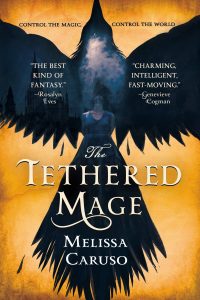 The Tethered Mage (2017)
The Tethered Mage (2017)
Written by: Melissa Caruso
Genre: Fantasy
Pages: 434 (Trade Paperback)
Series: Book 1 of Swords and Fire
Publisher: Orbit
The Premise:
Magic is scarce in the Raverran Empire, and those born with such powers are strictly controlled — taken as children and conscripted into the Falcon army, to be used as weapons in times of war.
Zaira has lived her life on the streets to avoid this fate, hiding her mage mark and thieving to survive. But hers is a rare and dangerous magic, one that threatens the entire Empire.
Lady Amalia Cornaro was never meant to be a Falconer. Heiress and scholar, she was born into a treacherous world of political machinations.
But fate has bound the heir and the mage. And as war looms on the horizon, a single spark could turn their city into a pyre.
As this is a book club discussion, there will be a few spoilers!
Discussion
I’m going to admit that I’m biased right off the bat. I wish like hell I’d written this book, because it contains so very many of the things that I strive for in my own writing.
Melissa Caruso gives the reader:
- Amalia Cornaro, a young heroine who is out of her depth, but starts from a baseline of intelligence and competence, who is self-aware enough to learn and change.
- A magical system that is rife for abuse as well as glorious use. Caruso has envisioned a system where warlocks are “jessed,” their powers put under control while they are still young enough to never mourn their freedom.
- A new companion who is full of raw power and attitude.
- A villain who is genuinely scary. Good villains are hard, people, seriously hard.
- A steadfast love interest who is also in over his head, and beginning to have doubts in the system he’s spent his entire life supporting.
- And of course, really good writing.
Let’s start with the opening scene, which introduces us to Amalia — her status, her personality, her interests. She’s the “typical” fantasy noble girl, sneaking off in breeches against her mother’s wishes to go to the bad section of town. Except, she’s not masquerading as a boy; she’s aware of the dangers and a little (a lot!) nervous. And she’s going to a bookstore to collect a rare magic book, because she studies magic — in a theoretical way, because she has no magical ability. In the Serene empire, magic theory is akin to scientific theory and Amalia is one hell of a researcher. She’s headed back home, contemplating donating the book to the university when she’s done (proving she’s generous) when she comes across three thugs accosting a young woman. Amalia considers slipping away to hunt down a soldier or a watch officer, but no one else is around and she steps in. With no magic. Without the trappings of her wealth. Only her certainty that someone needs to do something.
It goes wrong immediately. The young woman is not helpless. Far from it. Amalia is quick to put the clues together: the girl is angry, not afraid. Amalia ducks out of the way just as the girl bursts into flames — she’s an untethered warlock.
But Caruso keeps twisting expectations. The girl can’t stop emitting flame. Amalia recognizes the flames (from her research!) as balefire and knows that the entire city is about to turn to ash. A Falconer appears, and the day is saved! Except it’s not, because a Falconer can only bind one warlock at a time, and this Falconer is already bound. The only thing he can think to do is to give Amalia the jess to seal the girl’s magic.
Amalia is frightened but gets the job done. She burns her hand, her clothes, but — as she takes time to check — not her book. Everything is wonderful. Then the Falconer finds out who she is. In ten pages, Amalia’s life is permanently changed, and a political struggle is launched.
It’s forbidden, you see, for any of the Great Families to be a falconer. Yet, here is Amalia Cornaro, whose mother is the revered and feared head of a Great Family. When Amalia saved herself and the city, she creates an entirely new, bigger, and exciting problem.
It’s elegantly and entertainingly done.
I really like Caruso’s ability to twist the reader’s expectations. It keeps the story feeling fresh for a burned-out fantasy reader, and it also helps underpin one of her themes: every part of life is more complex and more nuanced than it seems.
Something that I’m finding as I write this is that The Tethered Mage is a hard book to talk about because so many of the events are so intricately linked to other events. If I start talking details, this discussion would be nearly as long as the book! And every scene I want to excerpt for you is a slow-burning one that would take 500 words or more to show.
So what I’m going to do is tell you some of the elements that I really loved and hope other readers did too.
The dialogue is delightful. There are careful political conversations where every word counts double; yet there are also touching personal interactions. There are amusing tongue-in-cheek observations, and wry thoughts.
Amalia attends a party and is surrounded by fortune hunters:
I remembered when I asked my mother how she dealt with fortune hunters as the wealthiest widow in Raverra: Just think about how you could have them all executed, she’d said. They see it in your eyes and they leave you alone.
p.104
Amalia is a gem of a protagonist: thoughtful, brave, willing to consider other sides of the proverbial coin. Morally upright. She is kind. She is clever. And at the beginning of this book, she’s only beginning to realize her strengths.
She is brave, but not brash. She’s self-aware. She wants to help people. She wants to protect them, using the abilities she has: her brains, her studies, her nascent training in politics. She wants to believe the best of people. This, even though someone tried to poison her as a child, and has left her carrying a death sentence in her veins barely controlled with daily antidotes. She’s a good person trying to do good things in increasingly complex situations.
Her love interest, Marcello, the young falconer, is the same way. They’re good people struggling to do the right thing in a complex world. Both of them have growing doubts about the system they’re a part of. And oh, their slow burn romance. Doomed for now — a lowly falconer and La Contessa’s only daughter? Not to be thought of. But in later books? Who knows…. I have both doubts and hopes.
The warlock magic is a wildcard in Raverra. It doesn’t seem to travel family lines. Anyone can be born with the mark. Marcello is falconer to his younger sister, who is gifted with the ability to make elaborate, magical machines. He lives with the daily fear that he’ll have to command his kid sister to kill for the Doge of Raverra.
That doesn’t mean this book is full of earnest people being earnest. Amalia’s mother is clever and manipulative even if it’s for generally good reasons. Zaira, the newly captive Falcon, is at first furious and hateful (for valid reasons!), and there are villains aplenty starting with slave trading thugs and ending up with Ruven, the evil witch lord. There are so many side characters who all feel like they’re leading their own lives when they’re not on the page… I love that.
It’s always a hard sell to convince the reader that a super-powerful magical minority can be easily controlled by a non-magical majority. Here, it is a system that makes sense. But it also doesn’t go unchallenged. After jessing a warlock, Amalia finds herself suddenly paying attention to the system she’s never questioned before. Like Hermione concerned about the house elves, Amalia starts asking, “but are the Falcons actually free? Are they happy?”
The jessed “falcons” live in comfort and are cared for, but are they treated like people instead of possessions? What is the vital difference between a falcon and a soldier when they both take commands at the doge’s will?
Unlike Hermione’s crusade, Amalia’s isn’t played for laughs, and it doesn’t present a simple answer. It’s another slow-burn plot point which I assume will play out in the next two books.
Then there’s the villain. Witch Lord Ruven is a counterpoint to Amalia’s concerns about the warlocks’ freedom. Compelling yet repellent. Not quite sane, but not irrational either. He’s dangerous as hell and his every appearance cements that fact. Ruven is part of entire society built in the inverse of theirs: where the magical minority are in charge. In Vaskandar, the magical minority is in charge, and people live in dread and fear. His first appearance on the page is terrifying and wonderful, and does a great job of showing how unchecked powerful magic is harmful, when he nearly melts a servant’s hand from his wrist for spilling a drop of tea. Only Amalia’s steady reminder that making a scene would be rude saves the servant.
The primary struggle in this book is over Ardence, a small city state that owes fealty to Raverra and is chafing under their restrictions. They’re being swayed by Ruven and the Vaskander promises. Amalia and Zaira are sent to Ardence to make peace. Or for Amalia to turn Zaira loose and burn the entire place to ash. Amalia, who attended college in Ardence and has multiple Ardentine ties of friendship naturally prefers peace. However; there’s a strong implication that the powers that be in Raverra would prefer that show of force, just as a reminder of their might.
One of the things I loved so much is how lived-in the worldbuilding felt. There are entire courses of study and authors that these people read and discuss. There are preferred foodstuffs and fashion and poisons. Caruso brings all sorts of walks of people to life: giving us the fantasy standard upper class, the lower class, and the merchants of the city. But also a vibrant set of students and middle-class siblings of politicians, etc. Her world feels really well-peopled with characters who have lives of their own when Amalia is not on the scene.
I think the only issue that gets muddy is one I’ve seen other reviewers complain about: that this should have been Zaira’s book. That she’s the powerful one shoved into what amounts to slavery and has to fight to get free. They’re not wrong. At the same time, I enjoyed Amalia and Marcello’s awakening to the injustice simmering within their own society and their slow steps toward understanding the ramifications and the reach of the problem. Yes, Zaira is the one in peril, the one unfairly caged, but there’s no subtlety in her story. She’s caged; she should be free. She has power; she wants to use it to escape this society. But having Amalia trying to figure out how to fix the problem really explores the unfairness of the falconer society in a way that I don’t think Zaira’s POV can. She’s not privy to the upper class machinations; she doesn’t see the lies and half-truths and uncomfortable facts that she’s fighting against.
I don’t know how this dilemma resolves itself in the trilogy. I’m looking forward to finding out. And maybe, yeah, at the end, I’ll say okay, this should have been Zaira’s story. So far, I’m good with Amalia as my lead.
In Conclusion
I really enjoyed this opening book of the Swords and Fire trilogy. If you didn’t have the time or interest in reading it before this book club, I hope at the very least I’ve convinced you to give it a chance at some point in the future.
Recommended Reading
For sensible, brave heroines with complicated love lives:
- An oldie! Robin McKinley’s The Blue Sword
- Another oldie: Diana Wynne Jones’ Howl’s Moving Castle
- Not quite so old: A College of Magics by Caroline Stevermer, but beware, this one is bittersweet!
For awesome world-building as well as wonderful characters:
- Martha Wells’ Death of the Necromancer. Really almost every fantasy she writes would be a book similar in tone to The Tethered Mage.
- The Golden City by J. Kathleen Cheney.*** A lovely, complex series opener about an alternate Italy peopled by Sirens, Selkies, and humans. The whole trilogy is delightful.
Participation Poll
June’s Book Club Selection: Midnight at the Blackbird Cafe by Heather Webber, hosted by Kelly McCarty on Friday, June 26th!
*** = Just for full disclosure Cheney is a friendly acquaintance.

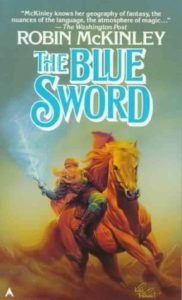
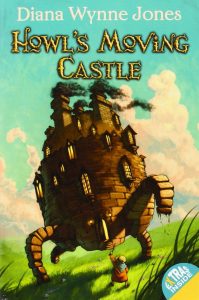
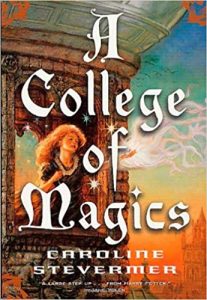
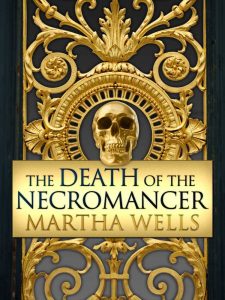
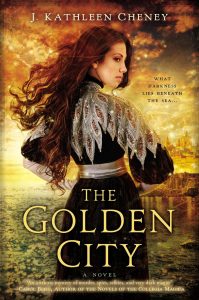
I’m about halfway through the book – I was waiting on the ebook from my public library, and it only arrived a few days ago. I’ve really enjoyed it so far. The characters are engaging and compelling, and I like the worldbuilding. This is a tricky story to tell – lots of troubling power dynamics and structures of privilege. And Amalia is definitely a complicated heroine, right in the thick of things with lots of unearned power and wealth. It would be interesting to see a version of the book that gives Zaira more of a protagonist role, as you discuss – shared narration might have been a nice way to get a deeper look at both sides. But not knowing what’s really going on in Zaira’s head is a big part of the tension of the book so far, so I can see why Caruso might not have chosen to go that route.
There were some aspects of the story development that didn’t totally make sense to me, particularly when there was a gap of days when Amalia doesn’t see Zaira, or when they cancel training for her to go to the party and it’s a problem. I think there wasn’t a clear enough sense of Amalia’s life outside of Zaira. I realized as I was writing this that we don’t see any friends of hers in Raverra – only her friends from Ardence. Maybe it wouldn’t have made sense to bring them into the story, since there are already *plenty* of characters to keep track of, but it makes her seem oddly rootless.
Anyway, that’s really a quibble. By and large, this is a great, fast-moving story with excitement, romance, and fun. Thanks for choosing it – I’m glad I had a reason to give it a shot!
Elena, I’m glad you’re enjoying it! I think it’s a fun read. That’s an interesting point you make about Amalia being friendless at home. I wonder if it’s due to her mother’s too-watchful eyes and her consciousness of her position. She does seem to have lived a much freer life in Ardence, probably another reason she’s so gung-ho to save it.
The Tethered Mage reminds that young adult fantasy is not my personal cup of tea, even though there were aspects of the book that I liked. I loved the cover art, although I spent the whole book thinking that someone was going to turn into a bird at some point. I also enjoyed the world-building and would have loved to have seen more of fashion/food/society of the Great Families. I also agree that Ruven was an interesting villain.
Amalia was just okay for me. I feel like I’ve seen similar heroines (smart, kind, naive, wants to save the world) too many times before. Zaira with her filthy mouth and wild spirit was a much more unique and interesting character. I really liked how casual the book was about Zaira’s bisexuality–that was definitely not something I ever saw in the young adult books of my actual youth. I think this would have been a better book if the narration had alternated between Zaira and Amalia. My favorite character in the story is by far, La Contessa. She was bad ass and I found myself wishing that I could have experienced this world through her eyes.
The romance between Amalia and Marcello was my least favorite part of the book. It felt very melodramatic and really reminded me that this was a young adult book. Perhaps I am a curmudgeon—I was rolling my eyes at teenagers when I was one. I wish I could read a fantasy book without any star-crossed lovers. It would have been a far more interesting choice to make Amalia and Zaira romantically interested in each other.
I’m glad that I read something out of my comfort zone, but I’m not sure if I will finish the series. Maybe if the library has the other books. When the library finally opens back up. Sigh.
Thanks for giving it a try! I really love Amalia just because I love the idea that a quietly ordinary seeming girl might be extraordinary in her own way, with or without magic. It’s one of my sure-fire ways to get me interested in a book. But I also loved Zaira. I didn’t mind the star-crossed lover thing, probably because he was such a nice boy, and there wasn’t some random love-triangle.
The Contessa is amazing, definitely.
So I don’t have a leg to stand on here, save for my years of noting a book’s target audience based off of who publishes, the cover art, etc., because I did not have the brain power to read this month, BUT nothing I’ve seen about this book suggests it’s targeted to the young adult audience. Aside from the ages of the characters (which in fantasy is never a reliable indicator), what made you feel this book was targeted to YA? I must preface here there’s nothing WRONG with any book being written for the young adult audience, but I’m leery of mislabels because too many people will dismiss a book if they believe it’s written for teens.
I didn’t think of this as YA myself when reading, but I did notice that a good number of Goodreads readers tagged it as YA. A deeper dive on Goodreads makes it clear that the author and publisher *don’t* consider it YA, but I can see why some readers interpret it that way. It uses a lot of common YA tropes – first person narrative, a young woman struggling with her relationship with a parents and with finding her own identity and place in the world, and as Kelly notes, a star-crossed romance.
I also think the book didn’t feel fully cooked, somehow – like it lacked a certain depth. I don’t actually associate that with YA – plenty of YA books are very deep and expertly crafted. But it did feel a little young, or immature, in its plotting and narration.